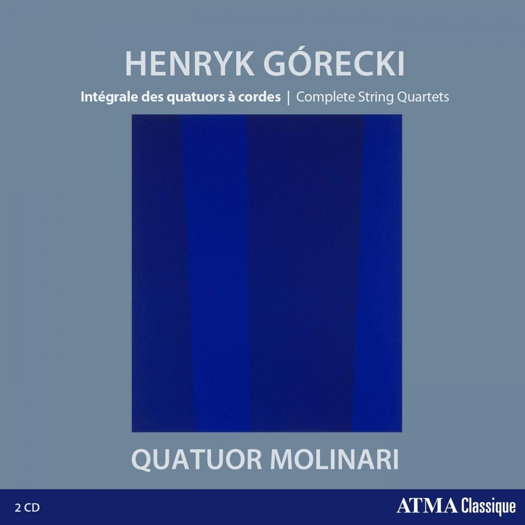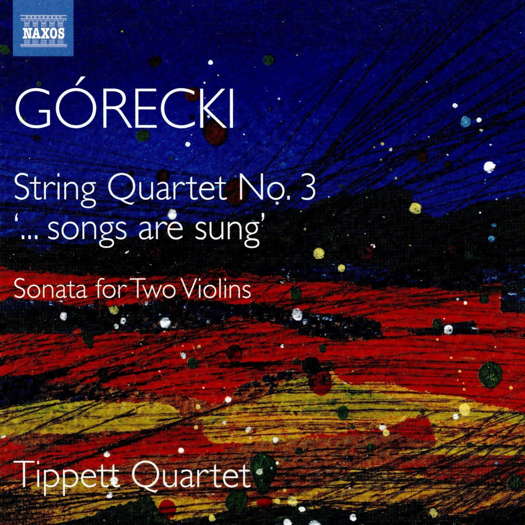 DISCUSSION: John Dante Prevedini leads a discussion about Composers, individuals or collective?, including contributions from David Arditti, Halida Dinova, Robert McCarney and Jane Stanley.
DISCUSSION: John Dante Prevedini leads a discussion about Composers, individuals or collective?, including contributions from David Arditti, Halida Dinova, Robert McCarney and Jane Stanley.
- Handel
- Yuzo Toyama
- Herzegovina
- Mihai Amihălăchioaie
- Soviet music
- Sarah Fox
- David Ying
- Richard Bannan
ARTICLES BEING VIEWED NOW:
- Régine Crespin
- Hector Berlioz
- Ruth Railton
- Marián Varga
- Marina Koshetz

Górecki's Strings
GIUSEPPE PENNISI compares two recent recordings of Górecki string quartets
'... Quatuor Molinari has a more melancholic approach than the Tippett Quartet.'
According to critic Alex Ross, no recent classical composer has had as much commercial success as Polish composer Henryk Górecki (6 December 1933-12 November 2010). His success was based on one composition and on one recording, featuring soprano Dawn Upshaw. Apart from two brief periods studying in Paris with Pierre Boulez and a short time living in Berlin, Górecki spent most of his life in southern Poland.
Górecki became a leading figure of the Polish avant-garde during the post-Stalin cultural thaw. Weberian serialism influenced his works of the 1950s and 1960; they were also characterized by adherence to dissonant modernism such as the compositions by Luigi Nono, Karkheinz Stockhausen and Krystof Penderecki. He continued in this direction throughout the 1960s, but by the mid-1970sm he changed to a less complex minimalism exemplified by the hugely popular Symphony No.3 (Symphony of Sorrowful Songs). The then avant-garde Polish, German and French establishment considered his change of style almost as an affront; but he continued to receive commissions from various Polish agencies, by the mid-1970s Górecki was no longer regarded as a composer that mattered. In the words of one critic, his new material was no longer cerebral and sparse; rather, it was intensely expressive, persistently rhythmic and often richly coloured in the darkest of orchestral hues.
As said in the previous paragraph, he was largely unknown outside Poland until the mid-to late 1980s, and his fame arrived in the 1990s. In 1992, 15 years after its composition, a recording of his Symphony No 3 released to commemorate the memory of those lost during the Holocaust became a worldwide commercial and had major critical success, selling more than a million copies and vastly exceeding the typical lifetime sales of a recording of symphonic work by a twentieth-century composer. As surprised as anyone at his popularity, Górecki said: ‘Perhaps people find something they need in this piece of music. Maybe, I hit the right note, something they were missing. Something somewhere had been lost to them. I feel that I instinctively knew what they needed.’ This popular acclaim did not generate wide interest in Górecki's other works, and he pointedly resisted the temptation to repeat earlier success, or compose for commercial reward.

Górecki: Complete String Quartets 2. Tippett Quartet. © 2020 Naxos Rights (Europe) Ltd
These three CDs - two in the ATMA album and one in the Naxos recording - do not include Górecki’s symphonic or other major orchestral works but an important part of his string chamber music. The ATMA two CDs include the three quartets composed between 1988 and 1994. The Naxos CD offers the String quartet No. 3 and the Sonata for two violins composed in 1957. The performers of the ATMA album are the Quatuor Molinari, a Montreal based ensemble specialized in works of the twentieth and of the twentieth first centuries. Those of the Naxos CD are the Tippett Quartet, a British ensemble quite often on BBC Radio 3. They focus on modern and contemporary music too as well in reimagining classical compositions for a modern and contemporary soundscape; they have done it for Beethoven Op 135 - one of his latest quartets. A previous Naxos recording includes Górecki’s Quartets Nos 1 and 2.
These CDs, hence, provide the opportunity to compare two performance styles, namely in Quartet No 3. This is an elaborate quartet, in five movements. It lasts almost an hour and had its premiere in 2005, hence ten years after its composition. Górecki gave it a title: Songs are Sung. This is part of a line by the Russian poet Vladimir Khlebnikov: When people die, they sing songs. Consequently, this quartet is quite important to appreciate Górecki. On the one hand, it is one of his latest works and it contains a summary of his different styles; on the other, it is almost his musical last will and testament.
From the outset, the careful listener will feel that Quatuor Molinari has a more melancholic approach than the Tippett Quartet.
Listen — Górecki: Adagio (String Quartet No 3)
(ACD2 2802 CD2 track 1, 0:00-0:57) © 2020 Disques ATMA Inc :
Listen — Górecki: Adagio (String Quartet No 3)
(8.574110 track 4, 0:00-0:50) © 2020 Naxos Rights (Europe) Ltd :
The different approaches can be heard also in the cantabile that concludes the first movement where the rhythm is stronger in the Tippett Quartet’s performance than in Quatuor Molinari’s.
Listen — Górecki: Adagio (String Quartet No 3)
(8.574110 track 4, 9:23-10:22) © 2020 Naxos Rights (Europe) Ltd :
Listen — Górecki: Adagio (String Quartet No 3)
(ACD2 2802 CD2 track 1, 10:37-11:35) © 2020 Disques ATMA Inc :
Similar comments can be made of the other movements, especially the final fifth movement, Largo - tranquillo.
Listen — Górecki: Largo - tranquillo (String Quartet No 3)
(ACD2 2802 CD2 track 5, 0:00-0:56) © 2020 Disques ATMA Inc :
Listen — Górecki: Largo - tranquillo (String Quartet No 3)
(8.574110 track 8, 0:19-1:08) © 2020 Naxos Rights (Europe) Ltd :
The differences are in slant and tilt; only very careful ears can distinguish them. In fact, both performances are quite good and mirror the intentions of an author that lived through half a century of modern and contemporary music.
This review does not deal with the other two quartets in the Molinari album because they are essentially steps toward the third and last quartet. For the readers, I think the Sonata for two violins is more interesting because it is the work of a musician at the time young and not yet influenced by serialism and by the Darmstadt seminar. Instead, I sensed a style drawing from Bartók and Prokofiev, full of dynamic contrasts, rivalry among instruments and sophisticated compositional technique, particularly for a twenty-five-year-old musician still studying at the State High School of Music in Katowice.
Listen — Górecki: Allegro molto (Sonata for Two Violins)
(8.574110 track 1, 0:00-0:58) © 2020 Naxos Rights (Europe) Ltd :
Listen — Górecki: Andante con moto (Sonata for Two Violins)
(8.574110 track 3, 0:00-0:58) © 2020 Naxos Rights (Europe) Ltd :
What skilful writing!
Copyright © 27 October 2020
Giuseppe Pennisi,
Rome, Italy

CD INFORMATION: GÓRECKI STRING QUARTETS - QUATUOR MOLINARI
CD INFORMATION: GÓRECKI STRING QUARTETS 2 - TIPPETT QUARTET
FURTHER CLASSICAL MUSIC ARTICLES ABOUT POLAND


